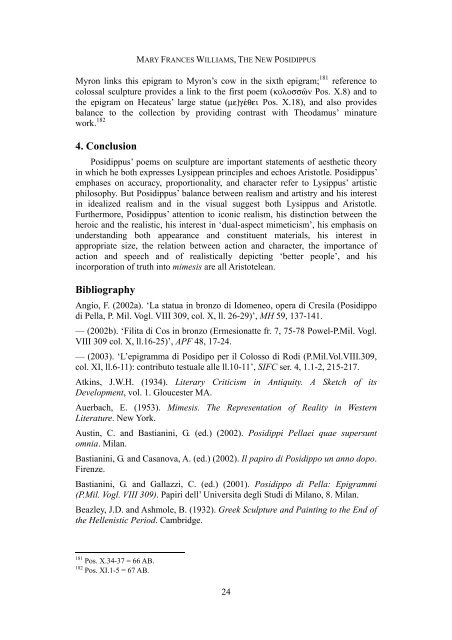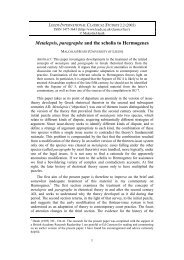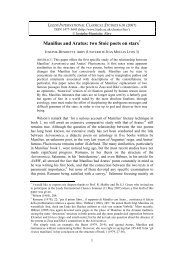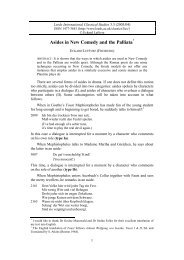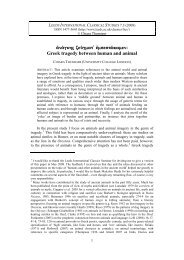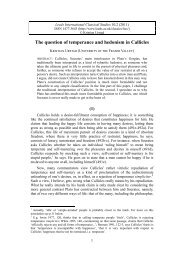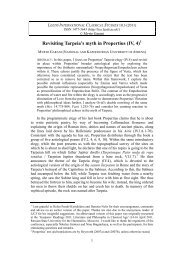The New Posidippus - Leeds International Classical Studies
The New Posidippus - Leeds International Classical Studies
The New Posidippus - Leeds International Classical Studies
You also want an ePaper? Increase the reach of your titles
YUMPU automatically turns print PDFs into web optimized ePapers that Google loves.
MARY FRANCES WILLIAMS, THE NEW POSIDIPPUS<br />
Myron links this epigram to Myron’s cow in the sixth epigram; 181 reference to<br />
colossal sculpture provides a link to the first poem (kolossîn Pos. X.8) and to<br />
the epigram on Hecateus’ large statue (me]gšqei Pos. X.18), and also provides<br />
balance to the collection by providing contrast with <strong>The</strong>odamus’ minature<br />
work. 182<br />
4. Conclusion<br />
<strong>Posidippus</strong>’ poems on sculpture are important statements of aesthetic theory<br />
in which he both expresses Lysippean principles and echoes Aristotle. <strong>Posidippus</strong>’<br />
emphases on accuracy, proportionality, and character refer to Lysippus’ artistic<br />
philosophy. But <strong>Posidippus</strong>’ balance between realism and artistry and his interest<br />
in idealized realism and in the visual suggest both Lysippus and Aristotle.<br />
Furthermore, <strong>Posidippus</strong>’ attention to iconic realism, his distinction between the<br />
heroic and the realistic, his interest in ‘dual-aspect mimeticism’, his emphasis on<br />
understanding both appearance and constituent materials, his interest in<br />
appropriate size, the relation between action and character, the importance of<br />
action and speech and of realistically depicting ‘better people’, and his<br />
incorporation of truth into mimesis are all Aristotelean.<br />
Bibliography<br />
Angio, F. (2002a). ‘La statua in bronzo di Idomeneo, opera di Cresila (Posidippo<br />
di Pella, P. Mil. Vogl. VIII 309, col. X, ll. 26-29)’, MH 59, 137-141.<br />
— (2002b). ‘Filita di Cos in bronzo (Ermesionatte fr. 7, 75-78 Powel-P.Mil. Vogl.<br />
VIII 309 col. X, ll.16-25)’, APF 48, 17-24.<br />
— (2003). ‘L’epigramma di Posidipo per il Colosso di Rodi (P.Mil.Vol.VIII.309,<br />
col. XI, ll.6-11): contributo testuale alle ll.10-11’, SIFC ser. 4, 1.1-2, 215-217.<br />
Atkins, J.W.H. (1934). Literary Criticism in Antiquity. A Sketch of its<br />
Development, vol. 1. Gloucester MA.<br />
Auerbach, E. (1953). Mimesis. <strong>The</strong> Representation of Reality in Western<br />
Literature. <strong>New</strong> York.<br />
Austin, C. and Bastianini, G. (ed.) (2002). Posidippi Pellaei quae supersunt<br />
omnia. Milan.<br />
Bastianini, G. and Casanova, A. (ed.) (2002). Il papiro di Posidippo un anno dopo.<br />
Firenze.<br />
Bastianini, G. and Gallazzi, C. (ed.) (2001). Posidippo di Pella: Epigrammi<br />
(P.Mil. Vogl. VIII 309). Papiri dell’ Universita degli Studi di Milano, 8. Milan.<br />
Beazley, J.D. and Ashmole, B. (1932). Greek Sculpture and Painting to the End of<br />
the Hellenistic Period. Cambridge.<br />
181 Pos. X.34-37 = 66 AB.<br />
182 Pos. XI.1-5 = 67 AB.<br />
24


